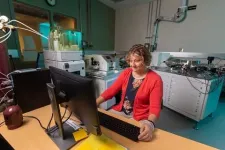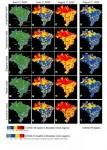Achondroplasia is caused by a rare genetic mutation that alters the activity of the fibroblast growth factor receptor 3 (FGFR3) gene involved in bone growth. Occurring in about 20,000 live births in the U.S. each year, the condition is marked by short stature, bowed legs, disproportionately large head and other musculoskeletal problems that cause pain, sleep problems and other symptoms.
Among other findings, the new study affirms that the vast majority -- at least two-thirds -- of those with the condition are born to parents of normal stature and bone development, meaning that the genetic mutation mostly arises spontaneously and randomly.
"We aimed to provide more uniformity of information about treatments in this field, because more precise information has great potential to improve therapies that alleviate symptoms and health problems among people with achondroplasia," says Julie Hoover-Fong, M.D., Ph.D., director of the Greenberg Center for Skeletal Dysplasias and professor of genetic medicine at the Johns Hopkins University School of Medicine.
A summary of the findings appeared in the May 18 issue of Genetics in Medicine.
Hoover-Fong says she and her colleagues had talked about doing this type of "look-back," or retrospective review of patient information for more than a decade, and began to do so in earnest in 2017. The data included medical records from 1,374 children and adults diagnosed with achondroplasia seen between 1957 and 2017 at one of four medical centers: The Johns Hopkins Hospital, Nemours/A.I. duPont Hospital for Children in Wilmington, Delaware, the University of Texas Health Science Center at Houston and the University of Wisconsin. There were an equal number of females and males, and 77.6% were white, 5.4% each were Black and Asian, 7.5% were Hispanic, 0.07% were Native American, 1.7% were a mix of more than one race or ethnicity, 1.7% were of unknown race or ethnicity and 0.4% were other ethnicities including those of middle eastern, African or South American descent.
"We collected everything we could find about patients who had been seen in our achondroplasia clinics, including archives, hard-copy charts and electronic medical records," says Hoover-Fong, who noted that medical centers transitioned through many types of medical record-keeping systems during the 60-year timeframe. The research team focused on four specific areas of study: anthropometry (growth), surgical history, sleep-disordered breathing and radiographic studies completed.
The challenge, says Hoover-Fong, was to identify comparable patterns and measures of physical traits, symptoms, therapies and outcomes.
One focus was on patterns of growth, including weight gain and head circumference among the patients from birth through adulthood, says Hoover-Fong, which are important for clinicians who need to know if their patients are growing as they should and for ensuring that different populations are evaluated appropriately in clinical trials of new therapies. Their database could be further improved by conducting similar analyses of information in people with achondroplasia worldwide.
The findings also confirmed evidence from previous studies that children with achondroplasia are more likely than the general population to be born preterm. Some 12.7% (174 of 1,374) of the study population was born prematurely. In the overall U.S. population, preterm births occur approximately 9.8% of the time. Most of the premature achondroplasia patients were born to mothers of average stature.
"Premature births in this population could be due at least partially to the large size of the fetus' head," says Hoover-Fong.
Analysis of trends in treatments revealed that limb-lengthening surgeries and use of growth hormone were relatively uncommon among patients, at only 1.2%. The surgeries can have a high complication rate, and are more common outside the U.S. where there are few or less-stringent laws providing protections and accommodations afforded by the Americans with Disabilities Act, says Hoover-Fong. Growth hormone, which come with the risk of serious side effects such as weight gain and diabetes, are not typically used among people with achondroplasia in the U.S. or most other countries except Japan.
By contrast, nearly 80%, or 1,094 of the patients in the study, had undergone at least one surgical procedure on ears, nose and throat, brain, foramen magnum (the opening at the base of the skull), spine or extremities to relieve pain, pressure, fluid buildup or other symptoms. More than half the achondroplasia patients had surgeries to insert pressure-equalizing tubes in the ears or to remove tonsils and adenoids. Such procedures are far less frequent in the general population of children of average stature (between 0.7 and 6.8%).
Among the achondroplasia patients, there were a "tremendous number" of X-rays and MRIs -- 10,727 -- likely a factor of the high number of surgical procedures, Hoover-Fong says.
Sleep apnea occurred among 38.4% of the achondroplasia patients, likely due to distorted bone growth in the head and throat. The prevalence of apnea among those with average stature is also high -- as much as 22%, according to some studies. "Medical professional societies have given resounding evidence and support that a series of evaluations, including an overnight stay at a sleep center, are necessary to properly assess sleep apnea in people with craniofacial differences, including those with achondroplasia. Yet, clinicians meet a lot of resistance from insurance companies to reimburse these evaluations," says Hoover-Fong.
The researchers' data also shows that, with the availability of molecular diagnostic tools, fewer patients with achondroplasia are going undiagnosed in recent times. Still, some children go a day, even up to a month without a diagnosis.
"Because those born with achondroplasia need early interventions, clinicians should have an immediate, definitive diagnosis right away," says Hoover-Fong. "We still have a lot of education to do so that more health care professionals can provide continual care for achondroplasia patients."
According to Hoover-Fong, more long-term, prospective studies are needed to improve pain management and well-being in patients, while reducing health care costs and increasing access to care.
INFORMATION:
The late Victor McKusick, M.D., began seeing patients with achondroplasia at The Johns Hopkins Hospital in the 1950s. He helped establish medical genetics as a specialty and led the world in searching for, mapping and identifying genes responsible for thousands of inherited conditions, including achondroplasia.
Funding for the study was provided by BioMarin Pharmaceuticals Inc., which makes an experimental drug called vosoritide for children with achondroplasia, and the Greenberg Center for Skeletal Dysplasias in the Department of Genetic Medicine at Johns Hopkins.
Hoover-Fong is also a paid consultant and speaker for BioMarin. This arrangement has been reviewed and approved by the Johns Hopkins University in accordance with its conflict of interest policies.
Other researchers who authored the study include Adekemi Alade, M.P.H., Chengxin Liu, M.P.H., John McGready, Ph.D., and Kerry Schulze, Ph.D., from Johns Hopkins; Shahrukh Hashmi, M.D., Ph.D., Jacqueline Hecht, Ph.D., David Rodriguez-Buritica, M.D., and Elena Serna from the University of Texas Health; Janet Legare, M.D., Peggy Modaff, M.S., C.G.C., Richard Pauli, M.D., Ph.D., and Cory Smid, M.S., C.G.C., from the University of Wisconsin; and Michael Bober, M.D., Ph.D., and Mary Ellen Little, B.S.N., from Nemours/AI duPont Hospital for Children.



